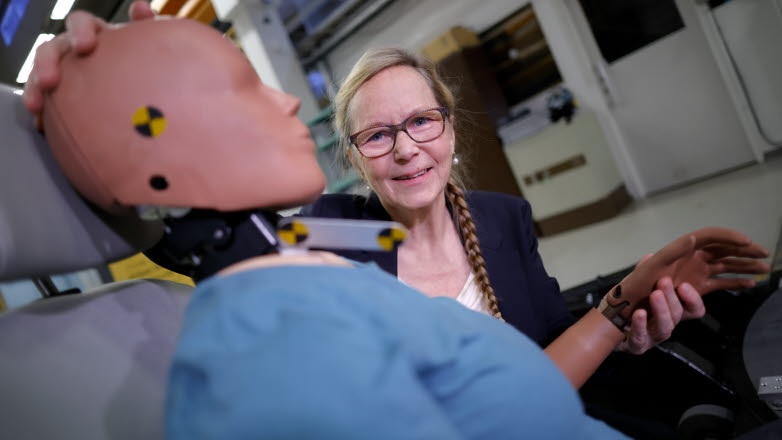First female crash test dummy displayed at VTI

Here they are. The world’s first average-sized female crash test dummy. And Professor Astrid Linder, a world-leading road safety researcher who spent 20 years developing the dummy. The objective is for women to have the same protection as men in a collision.
On Monday, female crash test dummy SET50F, and her male counterpart SET50M, were presented to Swedish journalists for the first time. The dummies were previously presented at an international road safety conference and attracted a great deal of interest and attention. SET stands for Seat Evaluation Tool, and 50 is the median value for the height and weight of real men and women.
Despite the fact that women are more likely to suffer injuries – especially to the neck and back – on the roads, all crash-test dummies have been modelled on the male anatomy to date. The new female crash test dummy is shorter and lighter, has a bust, wider hips and narrower shoulders. The stiffness of the neck is also different, as men generally have larger, stronger muscles.
The dummy is specially designed to test movement of the spine, neck and shoulders, with realistic softness in the body. The demonstration at VTI in Linköping included two crash tests that simulated a rear-end collision at 16 kilometres per hour. Despite the low speed, the tests clearly show the high forces exerted on the upper body and the risk of whiplash injuries to the neck.
“Injury statistics clearly show that women are less protected than men. But the statistics are presented in hindsight, and at the moment we do not have the right tools to evaluate how new vehicles best prevent injuries for both parts of the adult population,” says Astrid Linder, Professor at VTI and Chalmers University of Technology.
“Our model of a female crash test dummy can be used, together with its male counterpart, to evaluate the protection offered by car seats in preventing neck injuries so that both men and women are better protected in the future.”
Astrid Linder got the idea for the female crash test dummy when she did her PhD at Chalmers and discovered in a literature study that women had significantly less protection against whiplash injuries. A natural step, she felt, was to develop a crash test dummy modelled on the female physique. The dummy has subsequently evolved in stages since the early 2000s, becoming the SET50F that exists today.
All data from the development of the dummy is freely available to everyone. However, a decision on the design of the regulatory framework needs to be made by the UN in order to ensure that requirements are defined for the actual use of a crash test dummy of an average woman. The Swedish Transport Agency has been tasked with pursuing this issue, but this work –in the form of a working group in Geneva – has just begun.
“It is difficult to assess the extent of the opportunities and how long this might take. But this is a much smaller step than giving women the right to vote, which women do have in many countries,” says Astrid Linder, who said in a previous interview that “we are at the point in history” where this should be possible.
The SET development has been part of VIRTUAL, Open Access Virtual Testing Protocols for Enhanced Road User Safety. This EU project is funded by Horizon 2020 and consists of 15 partners in Europe. Besides Astrid Linder, coordinator of VIRTUAL, the research team has also consisted of research engineer Magnus Karemyr and Tommy Pettersson from VTI and Professor Mats Svensson from Chalmers.
Text: Mikael Sönne
Find out more about the VIRTUAL project: Open access virtual testing protocols for enhanced road user safety [Link to external website] External link.
External link.
Listen to Astrid Linder in the Vetenskapsradion series Forskarliv (in Swedish): Världens första kvinnliga krockdocka – redo att göra bilen säker även för kvinnor External link.
External link.
Don´t miss out on our news – subscribe now!
Stay informed with the latest research and news from VTI. Sign up for newsletters, sent by e-mail four times a year.
